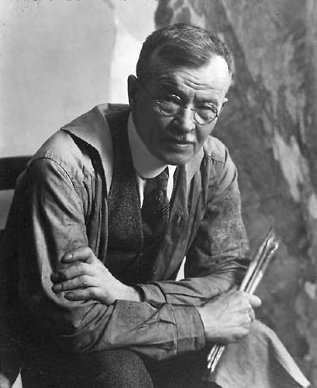- Carl Rungius
Infobox Artist
bgcolour = #6495ED
name = Carl Rungius

imagesize =
caption = Carl Rungius ca. 1920-1925
birthname =
birthdate = August 18, 1869
location = Rixdorf,Germany
deathdate = October 21, 1959 (aged 90)
deathplace =New York City
nationality = American
field =
training =
movement =
works =
patrons =
influenced by =
influenced =
awards =Carl Clemens Moritz Rungius (August 18, 1869 – October 21, 1959) was one of America's finest wildlife artists.cite web |url=http://personalitate.artline.ro/Personalitate-Rungius-Carl_Clemens_Moritz-254-2.html |title=Rungius Carl Clemens Moritz — January 1st 1970 |date=January 1, 1970 |publisher=Artline.ro |accessdate=2008-08-10] He was born in
Germany though he immigrated to theUnited States and he spent his career painting in the western United States andCanada . Active primarily in the first half of the 20th century, he earned a reputation as the most important big game painter and the first career wildlife artist in North America.cite web |title=Carl Runguis |url=http://www.glenbow.org/collections/art/research/rungius.cfm |publisher=Glenbow Museum |date=2008 |accessdate=2008-08-10]Life
Rungius was born in Rixdorf, now a part of
Berlin ,Germany , and spent most of his childhood inBritz , also part of Berlin.cite web |url=http://www.tfaoi.com/aa/3aa/3aa569.htm |title=Carl Rungius: Artist, Sportsman |date=2006 |publisher=Traditional Fine Arts Organization |accessdate=2008-08-10] His family had interests in art, nature, and taxidermy, and from an early age, Rungius enjoyed hunting and knew he wanted to be a wildlife painter. In late 19th century Germany, however, there was little undeveloped land and thus few hunting opportunities. His conceptions of America were influenced by popular conceptions, and to him it represented the freedom to hunt and paint on a majestic scale. Rungius studied art at the Berlin Art Academy from 1888-1890.In 1894, Rungius's uncle invited him to hunt
moose inMaine . Shortly after, in 1895, he travelled to Wyoming, which for him was an exotic experience. Big game, open skies, mountain scenes and big game abounded. He made extensive studies of his trophies, and stalked game, which allowed him to gain a better understanding of the animals he painted. In 1896, Rungius immigrated to the United States.Rungius found work, as hunters and naturalists commissioned wildlife illustrations for their magazines, books, and campaigns to protect endangered animals. Around 1909, he gave up illustrating to pursue a career as a full-time
easel painter. His illustrations, however, stayed in circulation long after, playing a large role in spreading information about ethical hunting. In early twentieth-century North America, there were few major zoos and photography was still in its infancy, so illustrations from books and periodicals were the public's main source of information concerning wildlife.His reputation as a wildlife painter had been greatly increased by a trip to the
Yukon territory in 1905. Rungius was plunged into the center of theconservation movement in America, promoted by such famous sportsmen as PresidentTheodore Roosevelt . In 1910, he accepted an offer to visit theCanadian Rockies , and would go on to paint a large number of his paintings there. He enjoyed the opportunities for hunting, exploration, and sport to such an extent that 1921, he built a studio inBanff, Alberta called "The Paintbox." He worked there from April to October every year until his death in 1959.cite web |title=Carl Runguis |url=http://www.wildlifeart.org/Collections/ArtistBio.cfm?tArtistid=262&tUrl=&UrlName= |publisher=National Museum of Wildlife Art |date=2007 |accessdate=2008-08-10]Art
Rungius was an avid sportsman, and spent more time in the wilderness than other artists. By direct observation in nature, he was able to gain an exceptional insight into the animals and their environment. Rungius painted both landscapes and wildlife, often with both into a single picture. He situated animals in their natural environment, a practice that was new to painting in early twentieth century North America. His paintings are highly romanticized, and represent an Eden-like world without any signs of a human impact.
Among other places, his works are featured at the American
National Museum of Wildlife Art , the DutchRijksmuseum Twenthe , andCalgary 'sGlenbow Museum .couting
In 1927, the
Boy Scouts of America created "Honorary Scouts" to distinguish "American citizens whose achievements in outdoor activity, exploration and worthwhile adventure are of such an exceptional character as to capture the imagination of boys...". Rungius was one of eighteen who were awarded this distinction.cite journal |date=August 29, 1927 |title=Around the World |journal=Time |url=http://www.time.com/time/magazine/article/0,9171,723029,00.html |accessdate=2007-10-24]Death
After Rungius's death in New York City in 1959, Eric Harvie, the founder of the
Glenbow Museum in Calgary bought the entire Rungius estate including paintings, sketches, photographs, personal belongings and mementos, and the entire contents of his Banff and New York studios. This huge collection of 1,404 items makes Glenbow Museum the premier research centre in the world for Rungius scholars.Rungius had his ashes scattered on
Tunnel Mountain inBanff, Alberta , loving the view overlooking the town and theBow Valley .ee also
*
Clarence Tillenius References
External links
* [http://findarticles.com/p/articles/mi_m1026/is_5_156/ai_57590152 Carl Rungius in context]
Wikimedia Foundation. 2010.
